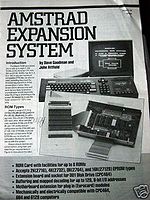Difference between revisions of "Maplin ROM Box"
From CPCWiki - THE Amstrad CPC encyclopedia!
(→Description) |
|||
| Line 17: | Line 17: | ||
== Technical == | == Technical == | ||
| − | ROM is selected using an I/O port decoded with A15=1, A13=0. The ROM number is decoded using D3-D0 only, meaning a maximum of | + | ROM is selected using an I/O port decoded with A15=1, A13=0. The ROM number is decoded using D3-D0 only, meaning a maximum of 16 ROMs can be used, but the PCB only has 8 sockets available. |
In addition more then one value can select the same ROM. | In addition more then one value can select the same ROM. | ||
Revision as of 04:55, 30 June 2011
Contents
Description
The Amstrad Expansion System aka Maplin ROM Card from Maplin is a DIY project by Dave Goodman and John Attfield.
The Amstrad Expansion System (Part 1) is primarily a rom box for the CPC series, but had additional features:
- Special non-standard Buffered Expansion Port (with pre-decoded IOSEL line, on access to "free" I/O addresss)
- Lightpen socket (3.5mm stereo socket - just a connector with LPEN,5V,GND - without any additional electronics)
The Amstrad Expansion System (Part 2) adds some more features:
- 6x8bit I/O port (using two 8255 PPI chips)
- Additional power-supply module (PSU)
Technical
ROM is selected using an I/O port decoded with A15=1, A13=0. The ROM number is decoded using D3-D0 only, meaning a maximum of 16 ROMs can be used, but the PCB only has 8 sockets available. In addition more then one value can select the same ROM.
Pictures
Manual
- Amstrad Expansion System Part 1: Maplin ROM-Box Manual (pdf)
- Amstrad Expansion System Part 2: 6x8bit I/O Port (pdf)








